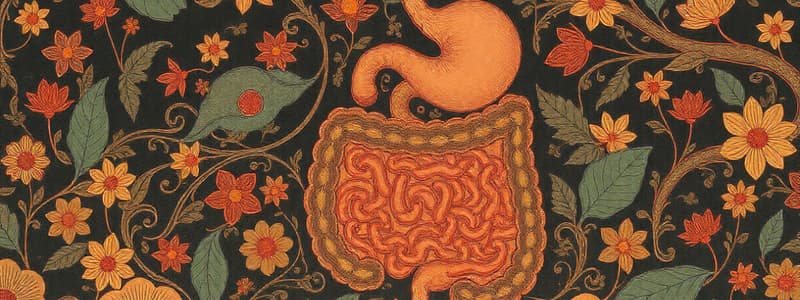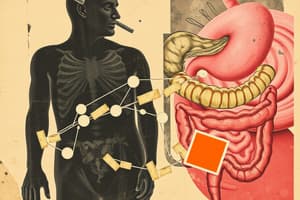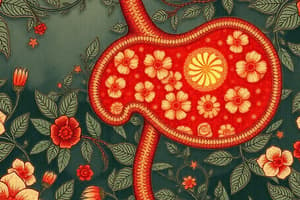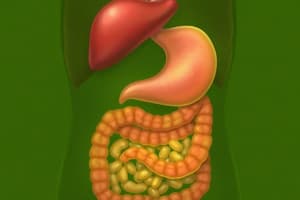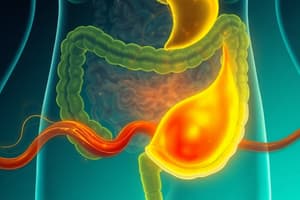Podcast
Questions and Answers
What is one of the primary roles of bile in the digestive process?
What is one of the primary roles of bile in the digestive process?
- Facilitates the secretion of gastric juices
- Increases the acidity of the stomach contents
- Inhibits the action of pancreatic lipase
- Emulsifies large fat particles into smaller ones (correct)
What substance is primarily excreted through bile as a result of hemoglobin breakdown?
What substance is primarily excreted through bile as a result of hemoglobin breakdown?
- Cholesterol
- Bile salts
- Glycogen
- Bilirubin (correct)
What stimulates the secretion of additional HCO3 ions into the bile?
What stimulates the secretion of additional HCO3 ions into the bile?
- Secretin (correct)
- Gastrin
- Insulin
- Cholecystokinin
How much bile can the gallbladder typically store at one time?
How much bile can the gallbladder typically store at one time?
What triggers the gallbladder to empty its contents?
What triggers the gallbladder to empty its contents?
What process primarily facilitates the absorption of bile components in the gallbladder?
What process primarily facilitates the absorption of bile components in the gallbladder?
What effect does the gallbladder's absorption have on bile?
What effect does the gallbladder's absorption have on bile?
Which of the following ions are secreted by epithelial cells in the bile ducts to increase the total quantity of bile?
Which of the following ions are secreted by epithelial cells in the bile ducts to increase the total quantity of bile?
What is the daily secretion range of bile from the liver?
What is the daily secretion range of bile from the liver?
What role does the gallbladder play in the absorption of electrolytes?
What role does the gallbladder play in the absorption of electrolytes?
What are the primary functions of bile salts in digestion?
What are the primary functions of bile salts in digestion?
What consequence can result from a lack of bile salts?
What consequence can result from a lack of bile salts?
Which of the following is NOT a lipid absorbed with the help of bile salts?
Which of the following is NOT a lipid absorbed with the help of bile salts?
What factors influence the amount of cholesterol in bile?
What factors influence the amount of cholesterol in bile?
What is the primary role of enterohepatic circulation?
What is the primary role of enterohepatic circulation?
Which condition is associated with high-fat diets and cholesterol metabolism?
Which condition is associated with high-fat diets and cholesterol metabolism?
What effect does emulsification by bile salts have on dietary fats?
What effect does emulsification by bile salts have on dietary fats?
What is a potential result of portal hypertension in the body?
What is a potential result of portal hypertension in the body?
What nutrient is most directly affected by bile salts during digestion?
What nutrient is most directly affected by bile salts during digestion?
Which structure in the liver receives blood from the hepatic portal vein?
Which structure in the liver receives blood from the hepatic portal vein?
Flashcards are hidden until you start studying
Study Notes
Bile
- Secreted by the liver
- ~600 - 1000 ml/day
- Important for two reasons:
- Fat digestion and absorption by emulsification of large fat particles into smaller ones that can be digested by lipase enzymes in pancreatic juice
- Aids in absorption of digested fat end products through the intestinal mucosal membrane
- Also important because:
- Serves as a means for excretion of several important waste products from the blood
- Bilirubin (an end product of hemoglobin destruction)
- Excess cholesterol
- Serves as a means for excretion of several important waste products from the blood
Biliary Secretion
- Initial bile produced in the liver contains water, electrolytes, and bile salts
- In its course through the bile ducts, a second portion of liver secretion is added to the initial bile
- This additional secretion is a watery solution of Na and HCO3 ions secreted by epithelial cells that line the ductules and ducts
- Increases total quantity of bile by as much as 100%
- Stimulated by secretin, which releases additional quantities of HCO3 ions
- These supplement the HCO3 ions in pancreatic secretion for neutralizing acid that empties into the duodenum from the stomach
Bile Storage in the Gallbladder
- The gallbladder can hold up to 30-60 ml of bile
- Over 12 hours, usually about 450 ml can be stored in the gallbladder
- This is because:
- Water, sodium, chloride, and most other small electrolytes are continually absorbed through the gallbladder mucosa
- This results in concentrated bile containing bile salts, cholesterol, lecithin, and bilirubin
- This absorption is mainly caused by active transport of Na through the gallbladder epithelium, followed by secondary absorption of chloride ions, water and most other diffusible constituents
Gallbladder Emptying
- Stimulated when fatty foods reach the duodenum, approximately 30 minutes after a meal
- Also stimulated less strongly by acetylcholine-secreting nerve fibers from the vagi and the intestinal enteric nervous system
- These are the same nerves that promote motility and secretion in other parts of the upper GI tract
Bile Salts
- Salts of bile acids
- Used for two things:
- Form small physical complexes with lipids called micelles
- Help in the absorption of fatty acids, monoglycerides, cholesterol, and other lipids from the GI tract
- Emulsifying or detergent function breaks down fat globules into minute sizes
Enterohepatic Circulation
- The bile salts are reabsorbed in the terminal ileum
- Return to the liver via the portal vein
- Secreted back into bile
- This constant recirculation conserves bile salts
Regulation of Biliary Secretion
- The amount of cholesterol in bile is determined partly by the quantity of fat the person eats
- Liver cells synthesize cholesterol as a product of fat metabolism in the body
- This is why people who consume a high-fat diet over a period of years are prone to developing gallstones
Portal Hypertension
- Portal hypertension is an increase in pressure within the portal vein
- Occurs when there is a blockage of blood flow through the liver
- Can lead to a variety of complications, including ascites (fluid buildup in the abdomen), esophageal varices (enlarged blood vessels in the esophagus), and hepatic encephalopathy (confusion and disorientation)
- Commonly caused by cirrhosis, a chronic disease of the liver
Microscopic Anatomy of the Liver
- Liver receives blood from two sources:
- Hepatic artery: carries oxygenated blood from the heart
- Hepatic portal vein: carries nutrient-rich, deoxygenated blood from the digestive tract
- Liver cells (hepatocytes) are responsible for:
- Bile production
- Protein synthesis
- Glucose metabolism
- Detoxification of harmful substances
Studying That Suits You
Use AI to generate personalized quizzes and flashcards to suit your learning preferences.
